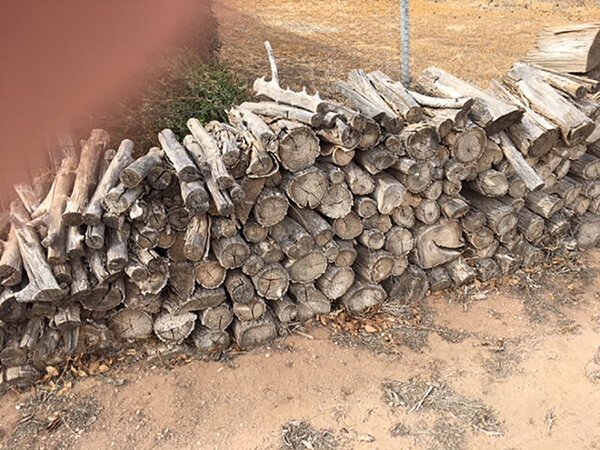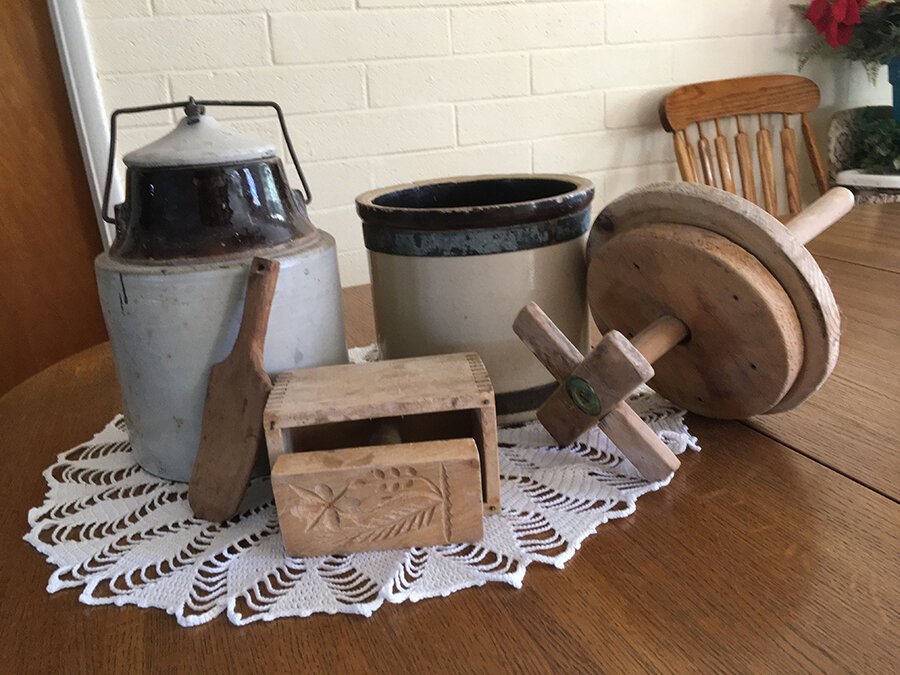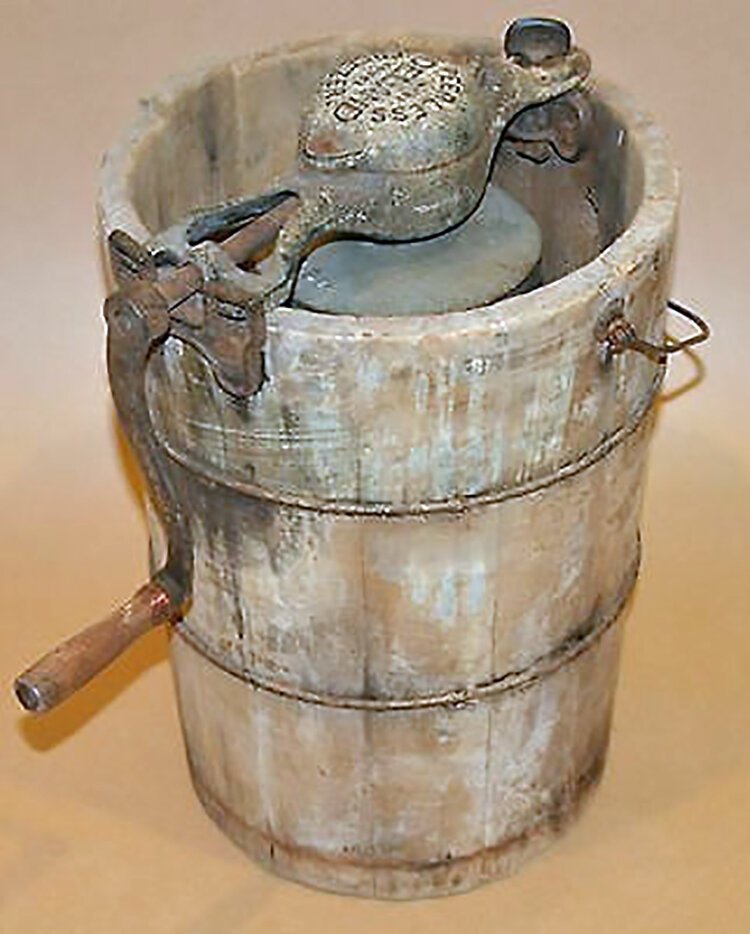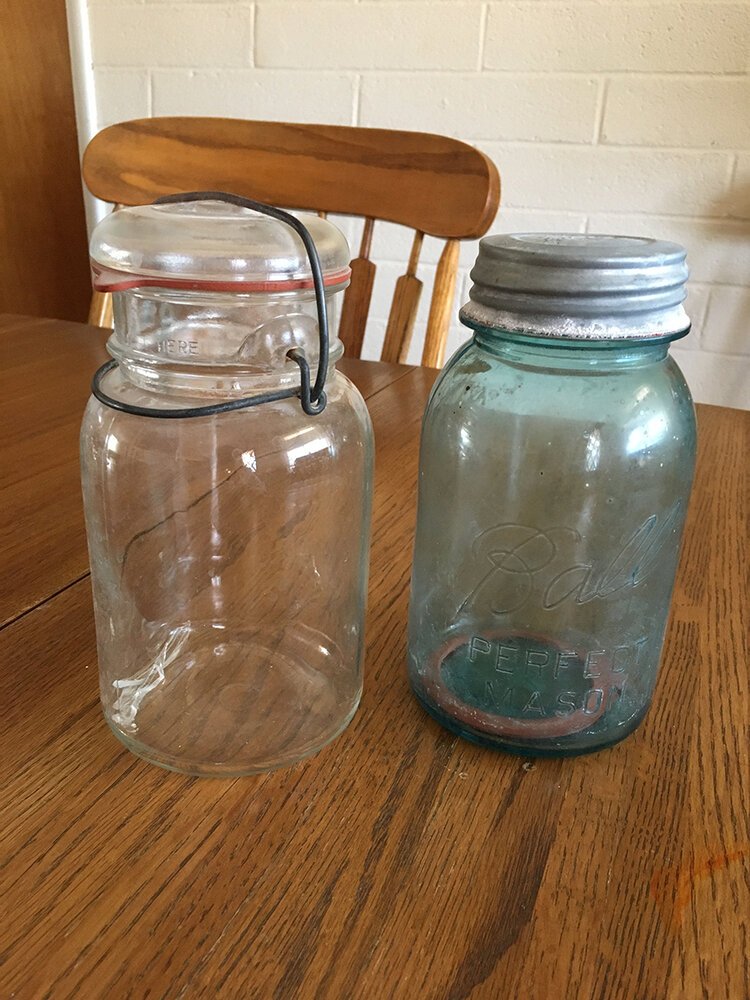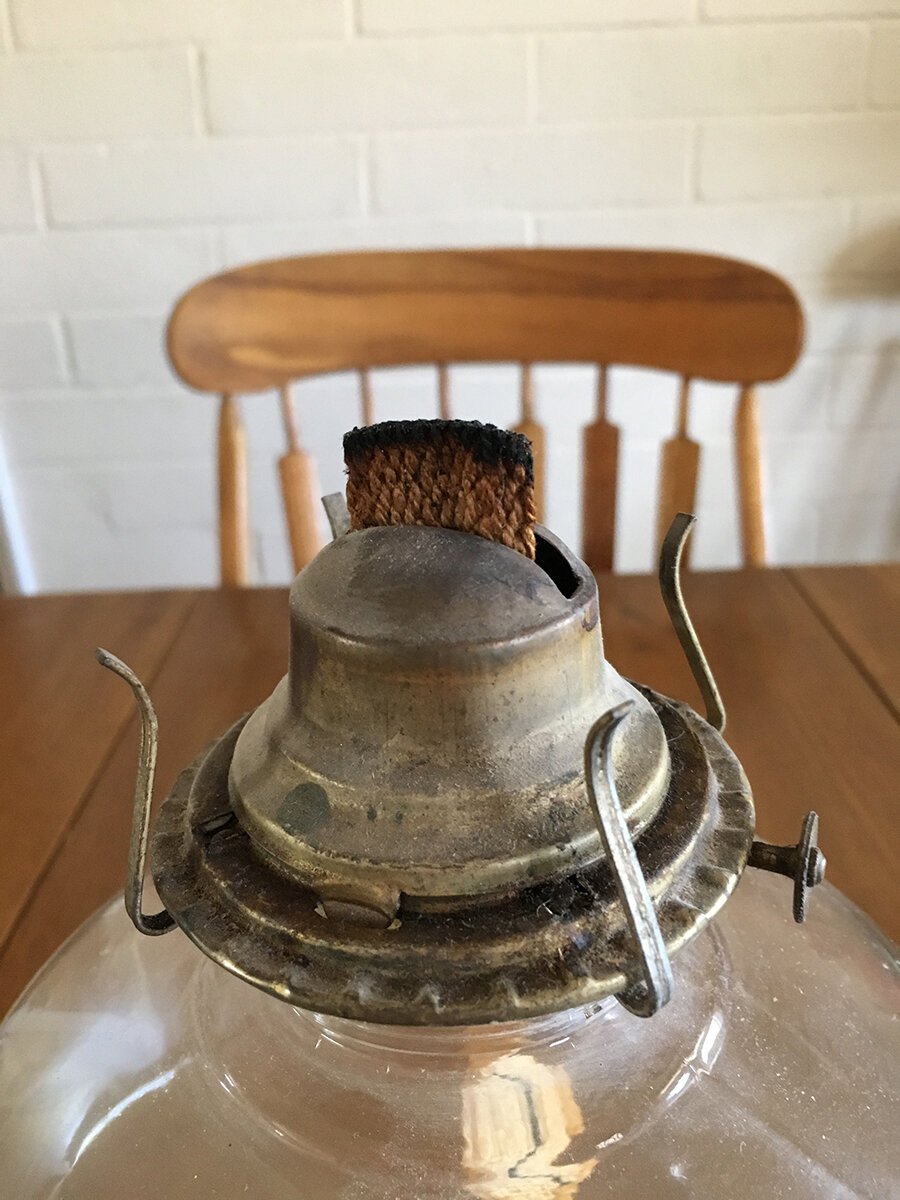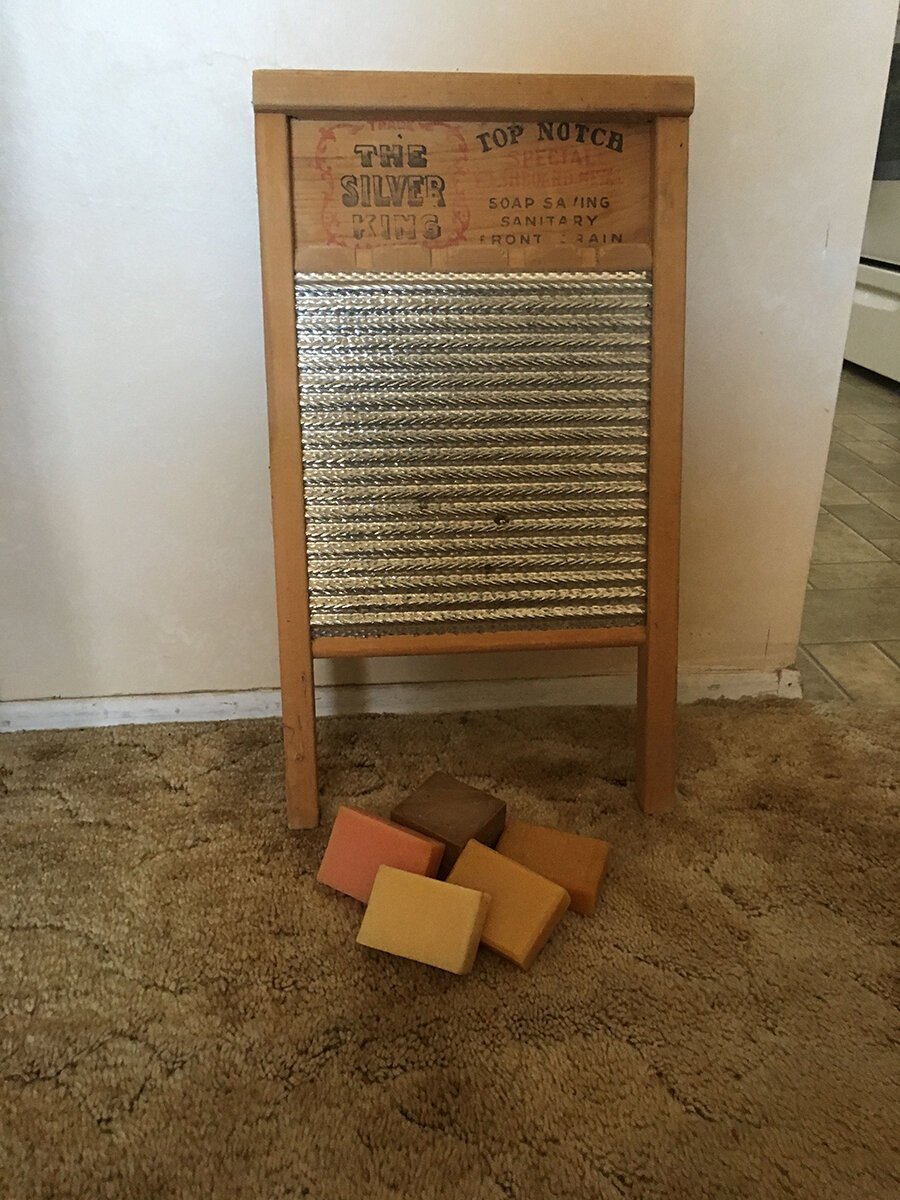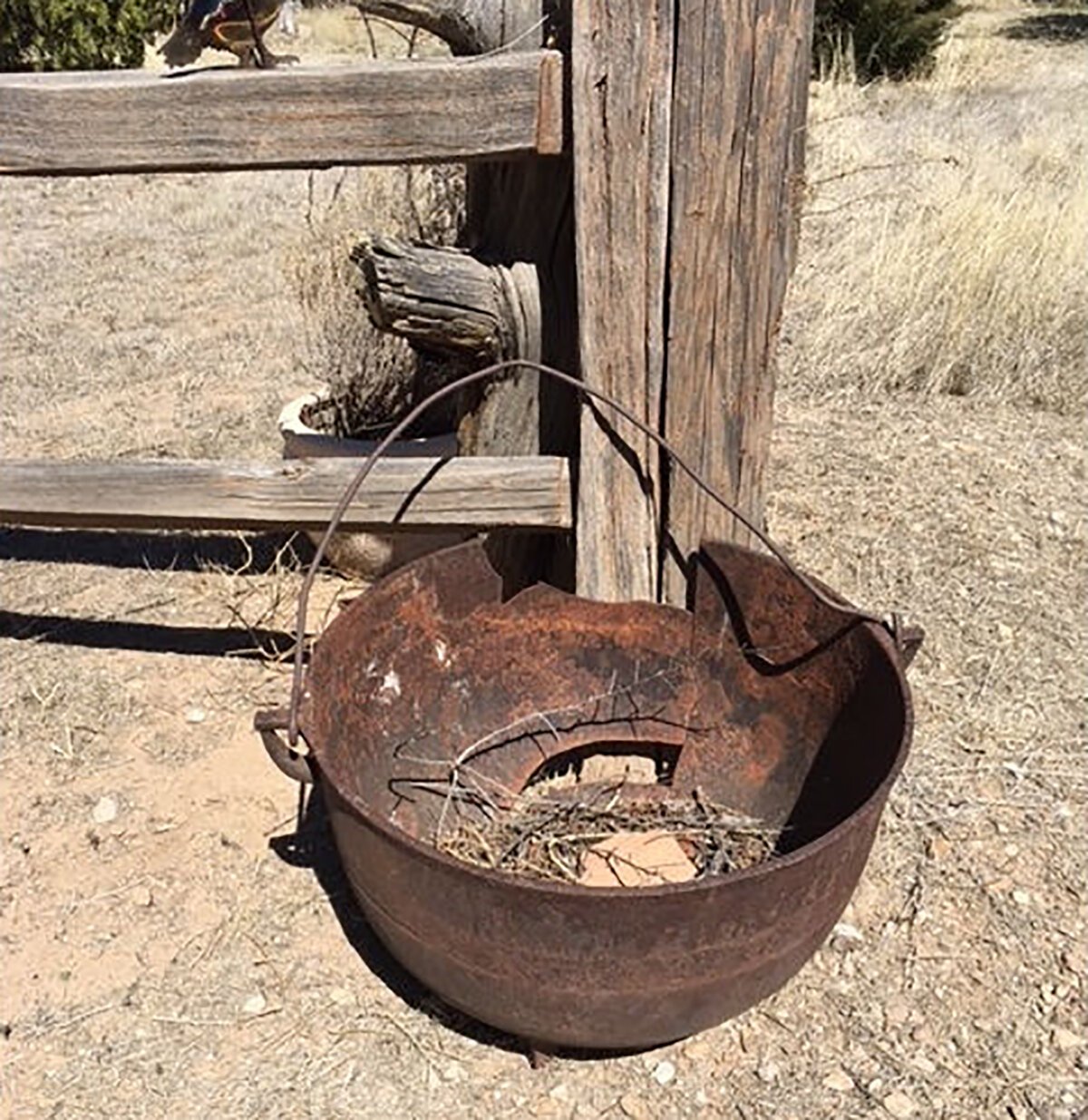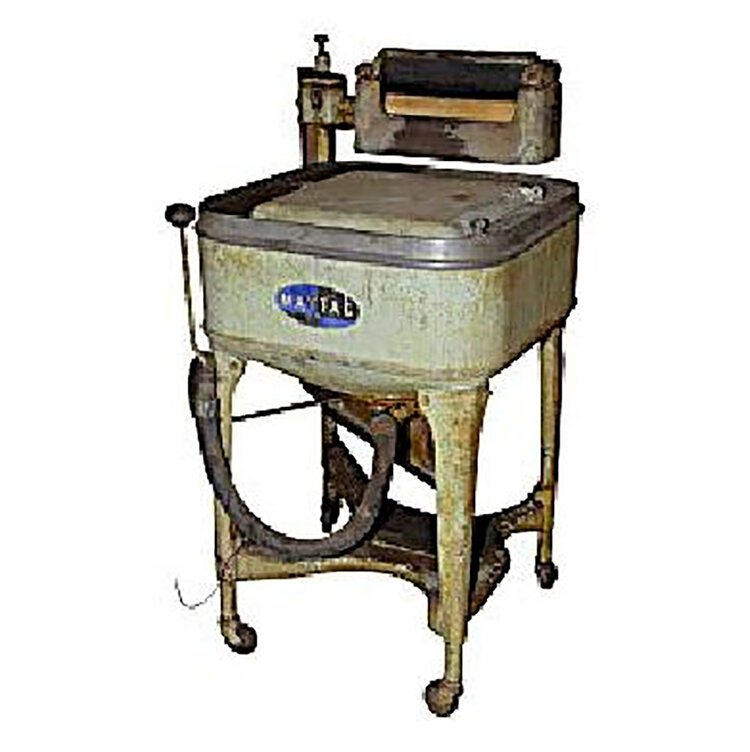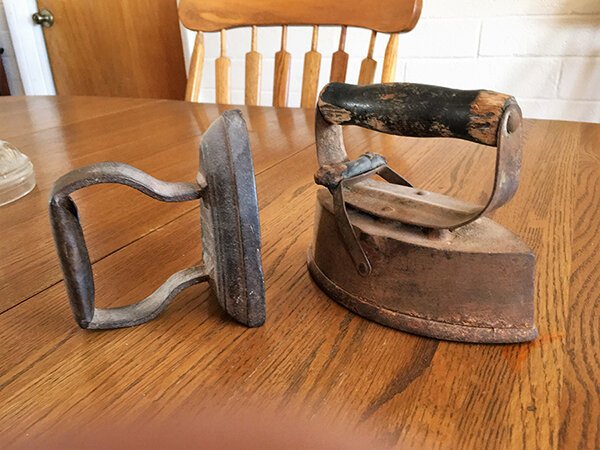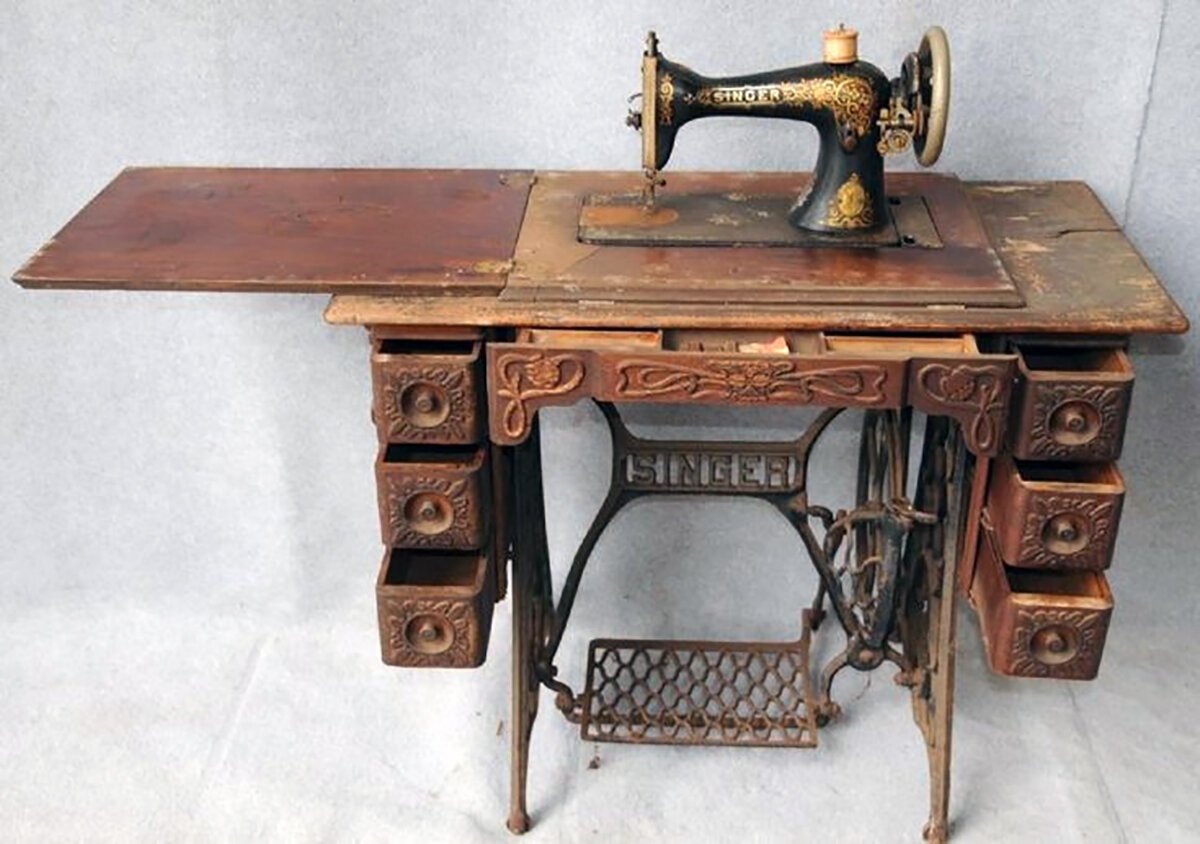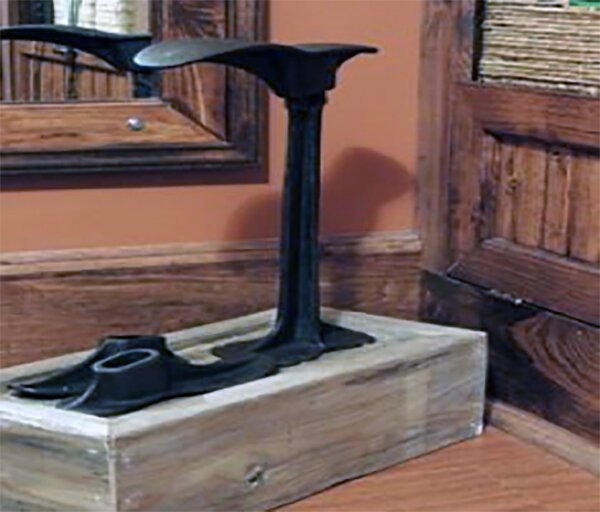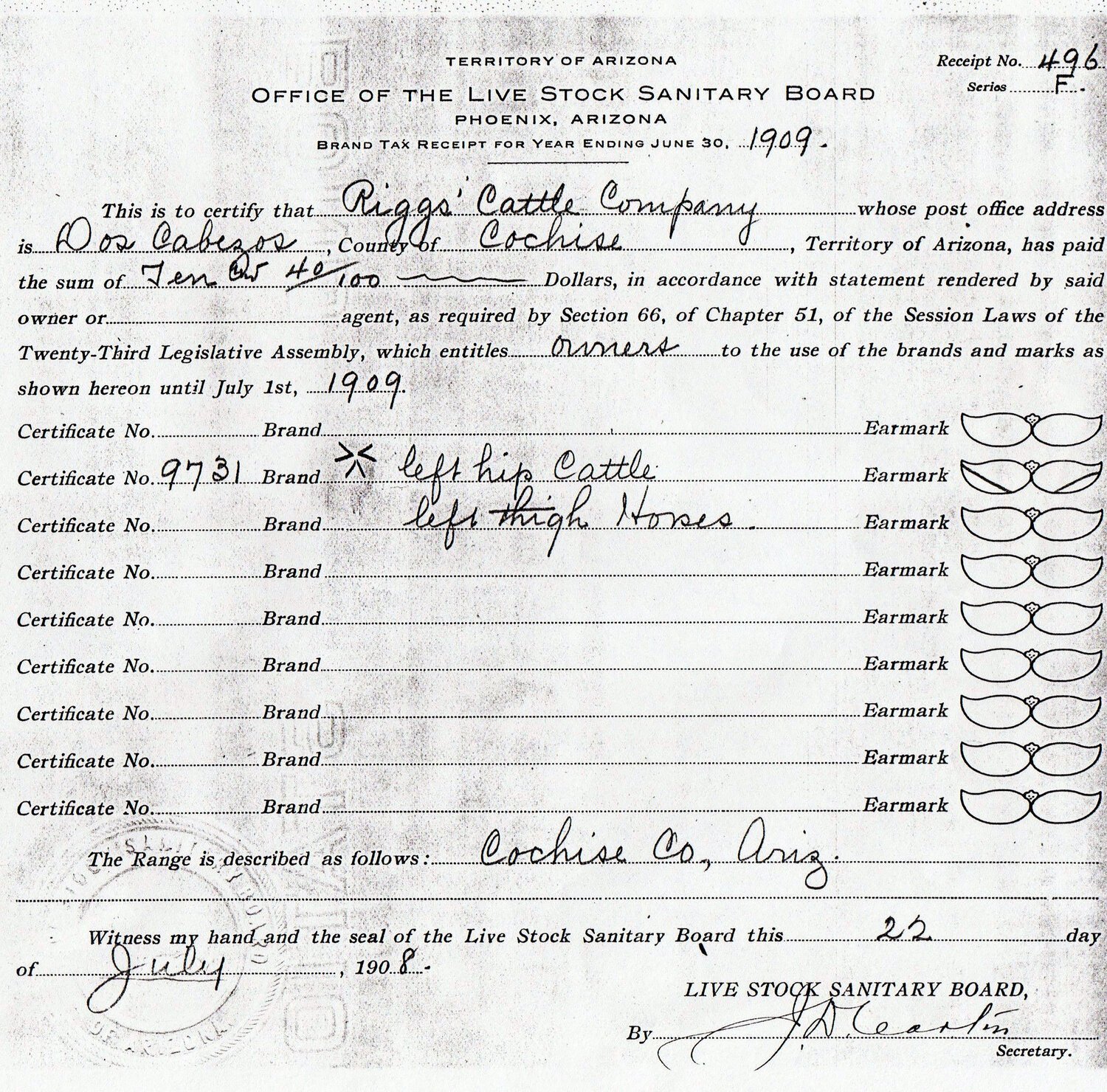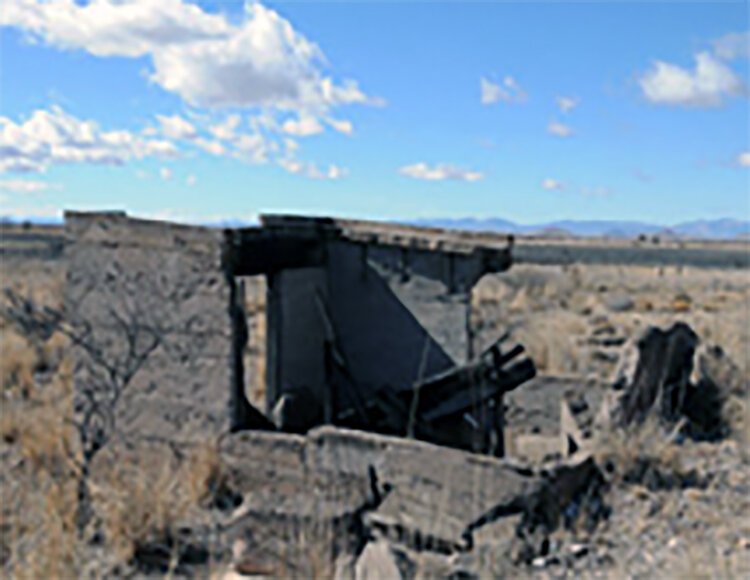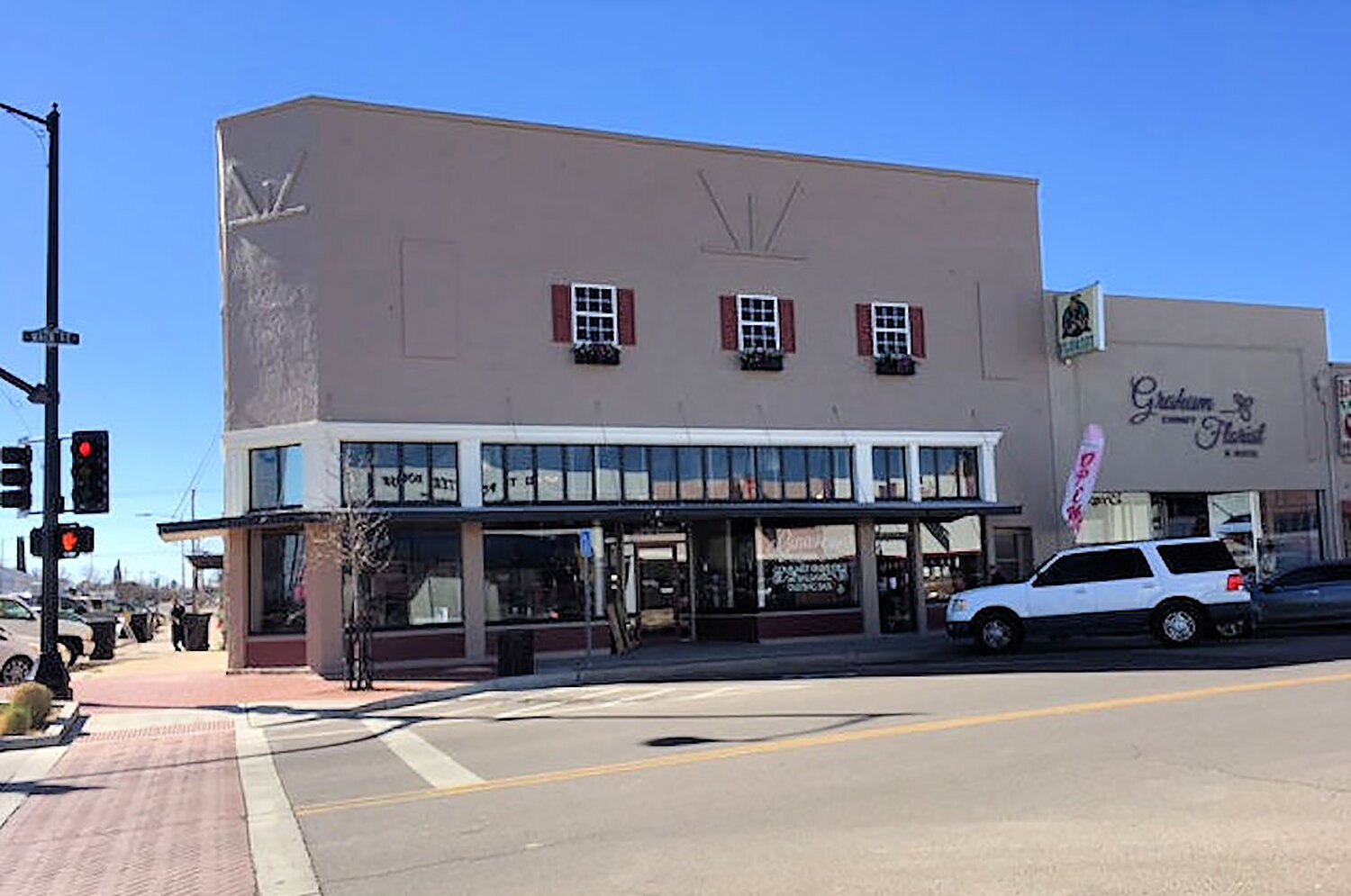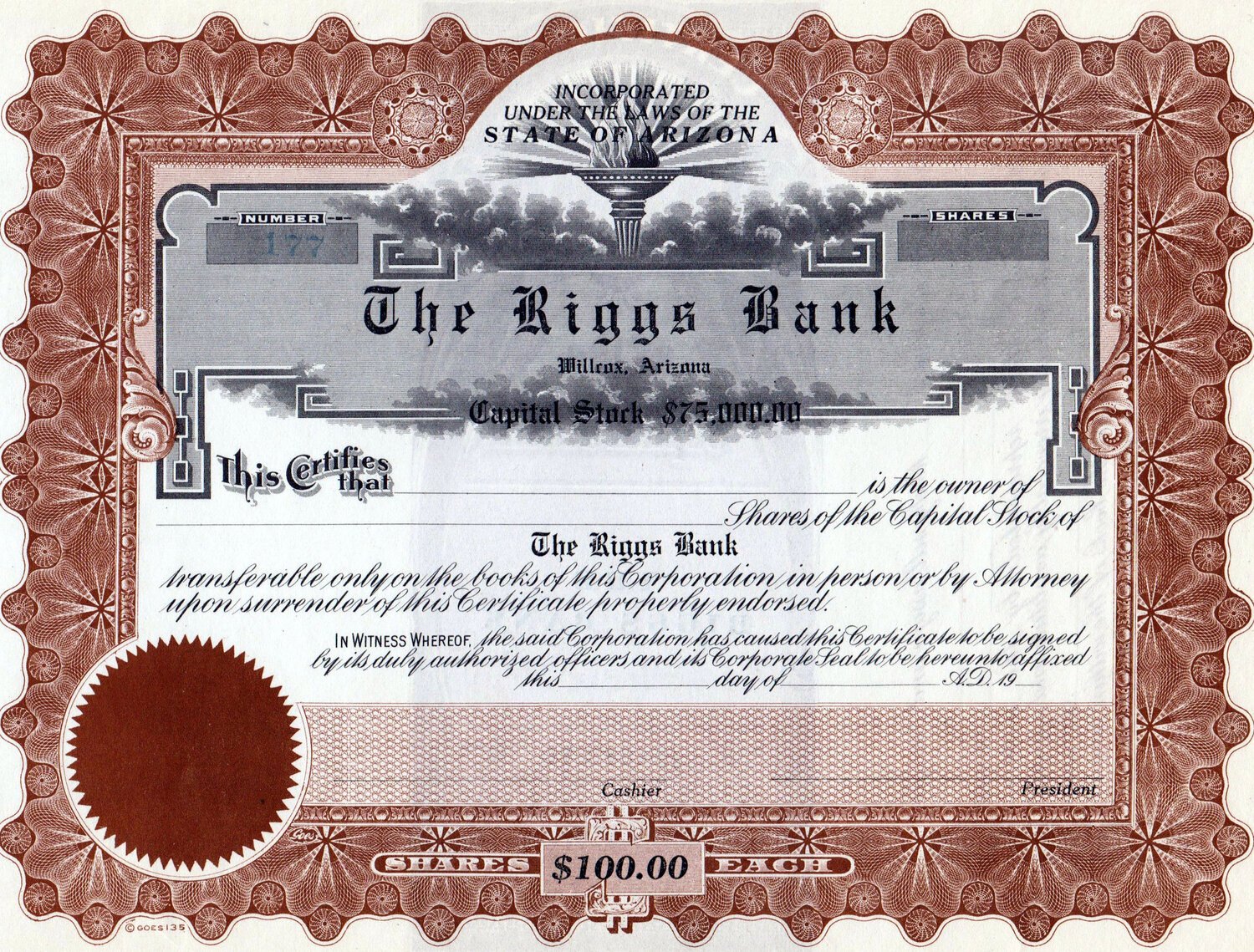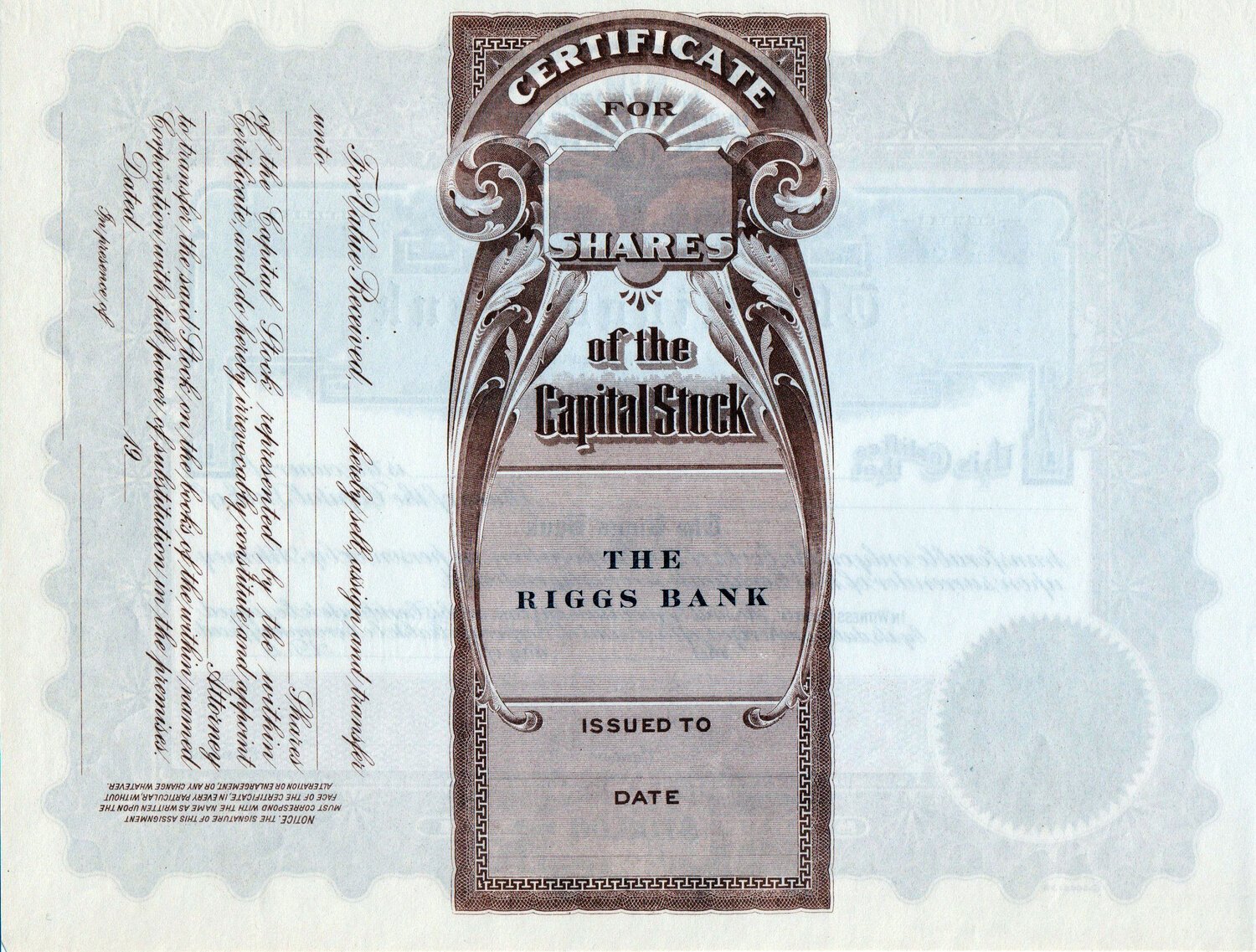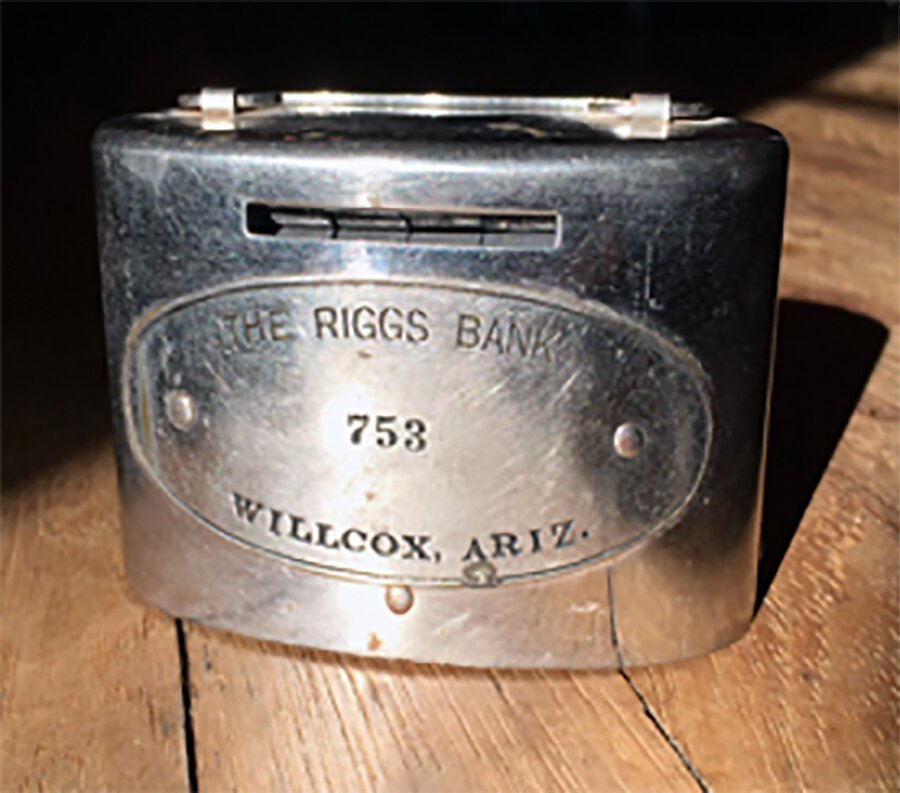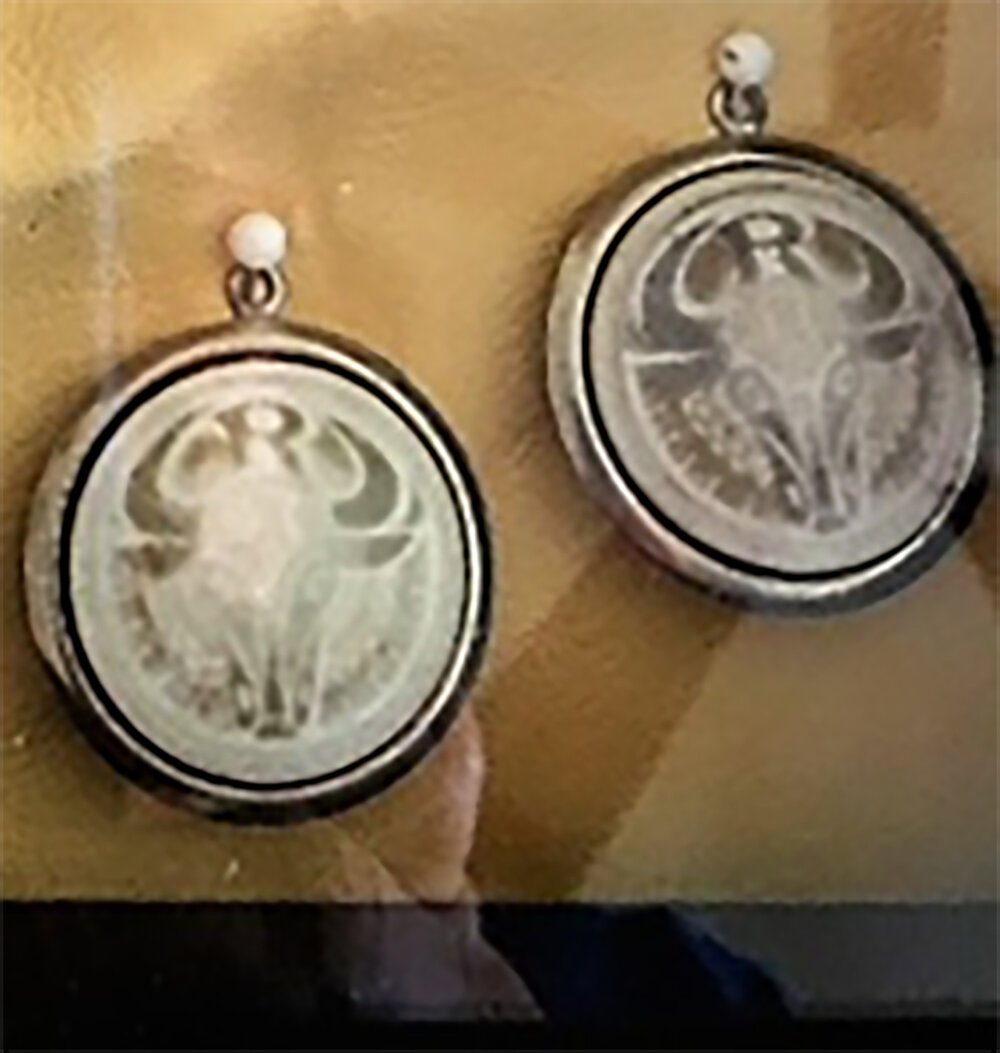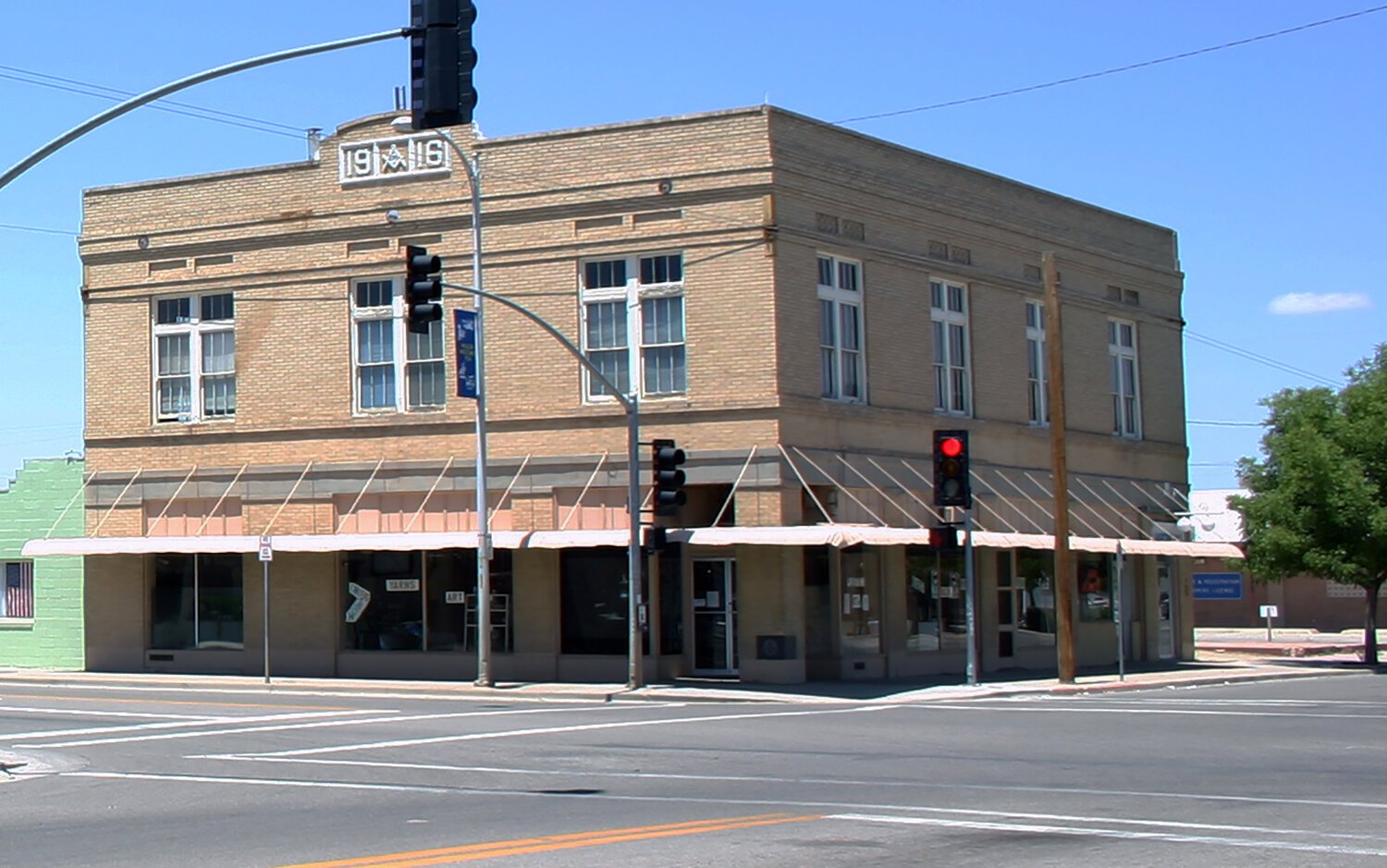MARY ELIZABETH RIGGS: MY STORY (CONTINUED)
PAGE 3 OF 3
MARY ELIZABETH (ROBBINS) RIGGS
FOR WOMEN
Life in the early days of ranching was not any easier for me or the girls as we did the inside work of caring for the children, growing and preparing the food, keeping the home clean, and the clothing clean and in repair and to occasionally help out with the riding as needed.
It was necessary for us to rise early, start the fires and prepare the breakfast for our family. This was often before day light so that the men could be ready to ride at sunup. After breakfast the table was cleared, food taken care of and the chores of the day begun. Each day’s chores may be different but the following are areas that were our main responsibilities.
These are some of the things that had to be done on a regular basis in order to have food at meal times. One activity that was vital daily in my home was the building of fires. Sometimes Mr. Riggs or one of the boys would get up, build the fires then go back to bed while the girls and I got up and prepared food and in general got our day started. In cold weather our original house was heated by a fireplace in each of the four rooms and a wood burning stove in the separate kitchen. Food was cooked on the wood burning stove which, in our case, had been hauled from Texas to Colorado to Arizona. Water was heated over a fire in order to bathe, clean the house and wash clothes and dishes. Wood was stacked by cords in a place readily assessable to the house. A wood box was in the house where wood was placed to keep it dry and handy for the days use. The chore of keeping the wood box full I usually assigned to a younger child.
STACKED CORD OF FIRE WOOD
Food supplies were purchased at a store when Mr. Riggs went to town on business. Supplies usually consisted of bags of flour, sugar, beans, dry corn for cornmeal, salt & pepper, lard, coffee, tea, cream of Tartar, baking powder & baking soda, oats & barley, vinegar, salt pork & a side of bacon, molasses or honey, Bluing to whiten clothes, Lye to make soap and bolts of material and needles for making clothing. We also needed coal oil for our lamps or candles.
Periodically a beef or pig was butchered. Meat would spoil quickly, so when an animal was killed the meat was shared with family and neighbors. Mainly in the winter when it was cold enough the carcass would be wrapped in canvas and hung high in the barn. When meat was needed it was lowered, a portion of meat cut off, then it would be rewrapped and hung again. What beef wasn’t used fresh we would make into jerky.
DRYING JERKY ON WIRES
Jerky is made by cutting the beef into thin strips, covering it well with salt and pepper and hanging it over stings or wires and leaving it out in the air to dry. It would be covered lightly with material to keep the flies off as it dried. We also kept pigs which we butchered and shared. Hams and bacon would be hung in a smoke house to be cured. We raised chickens and turkeys for eggs and meat. When chickens or turkeys were butchered they would be used immediately by our family or sold.
“20 Rhoda butcherd her turkeys taking them to Willcox an Sold them at 20 cents a pound”
Mayor's Market has ordered a fine lot of Thanksgiving turkeys from Mrs. Rhoda Riggs. They are expected to arrive about Tuesday.
Arizona Range News
Friday, 25 Nov 1904
Miss Rhoda Riggs was in town Monday and delivered a fine lot of Thanksgiving turkeys to Mayor's Market.
“21 Rhoda went to Willcox with her turkeys 12 little chickens off”
When it was needed, a large batch of bread dough was mixed and set to rise in a warm place. Depending on the weather this could take anywhere from 2 to 5 hours. At first homemade yeast or sourdough was used as the leavening for bread. When the dough had doubled in size it was punched down, divided, placed in bread pans, allowed to rise again, and then baked in the oven of the wood burning stove. If sourdough was used for leavening it had to be tended to each day to keep it growing properly. This was done by not using all of the sourdough starter in the crock at one time and adding equal amounts of flour and water to the starter to feed it. It was then kept in a warm place to ferment and grow. I didn’t make very good raised bread.
“I was Sick and made Sour bread a gain”
Mr. Riggs didn’t like raised bread, preferring biscuits. This was great when we were traveling. Biscuits can be mixed, shaped and cooked immediately in a Dutch oven. You don’t have to wait for them to rise like you do with light bread. I made fresh biscuits for him for each meal. Because he was the head of our home, Mr. Riggs was always served first. He would take a biscuit, pull it apart, put the top on his plate and return the bottom to the plate for the children to eat. Pancakes and cornbread were also used as bread. Milk cows were for many years the mainstay of my family. They required milking each morning and evening. This was usually done by the girls or me.
DAILY MILKING
Milk was strained into enamel pans, through material, such as cheese cloth, to keep out dirt and trash, then set aside in a cool place, such as a well house, a root cellar or an evaporative desert cooler, to cool and let the cream rise. A desert cooler consisted of a box framework with a couple of shelves inside. The outside was covered with layers of burlap. It was then placed in a shady place where there was a breeze most of the time. It was set up so that water constantly dripped down all sides, keeping the burlap wet. The breeze blowing though the wet burlap cooled the inside of the box keeping the milk cool. When the milk was used the cream was skimmed off the top and set aside in a container. When enough cream was accumulated we churned it into butter. This was done by pouring the cream into a crock, putting a lid in place that has a hole for the handle of a plunger then working the plunger up and down through the cream until the yellow fat solids separate from the liquid milk. The buttermilk was poured off and used as a refreshing drink. There is still buttermilk remaining in the butter that needs to be worked out of the butter with a wooden paddle. Water would be added until all of the milk had been worked out. A little salt is then worked into the butter for flavor. The butter was then put in a butter mold and left in a cool place to harden. When it was hardened the butter would be pushed out of the mold to be used by the family. Each year I “put down butter”. This was a way of preserving butter. I would melt the butter on the stove until it separated into a clear, golden liquid and a milky sediment. I would carefully pour off the golden liquid, straining it through a piece of clean muslin. The milky sediment would be given to the pigs. The clear butter would be put into a hot sterilized glass jar and sealed. It was cooled, then stored in the root cellar. Buttermilk, the milk left after the butter has been churned out of the cream, is also used. It is very refreshing to have a cold glass of buttermilk on a hot day. Pancakes and biscuits made with buttermilk are light and fluffy. Another way we use fresh milk is to leave it set out on the table until it becomes clabber – the milk becomes curdled and separates from the whey. We then cool it, add some sugar and enjoy a glassful on a hot day. Clabber is one of the first stages of making cheese. If the cream soured we used it to make cookies and cakes.
SOURDOUGH CROCK, BUTTER CHURN, BUTTER MOLD & HAND CARVED BUTTER PADDLE
Ice cream was a favorite treat of our family. We had plenty of cream and eggs and ice became available from the ice plant at Fort Bowie and later from Dos Cabezas so we had ice cream often.
“9 the girls got a cream freezer
4 we ar having ice cream
the children come”
HAND CRANKED ICE CREAM FREEZER
Another chore the girls and I did on the ranch was to help with feeding “Dogie” calves (calves that had no mother). It wasn’t easy trying to keep a calf alive that had no mother. We devised various methods of letting a new calf nurse. The most successful way to take care of them was to find what we called a “Dogie Cow”, one that would allow a calf other than her own to nurse. Just like people that just mother everyone, some cows will just mother any and all calves.
We added variety to our food supply with the wild animals available in the area such as deer, fish and ducks.
“4 BB come him an aunt Rhoda Miss heath went to the tanks after ducks got them ”
We planted fruit trees that the girls and I watered and cared for. Among the family we had some nice orchards. When the fruit was ripe and harvested, it would be dried or bottled in canning jars. We also planted a large garden to supply the vegetables our family would eat. What wasn’t eaten fresh was preserved by drying or canning, or stored in a root cellar for later use. Summer and fall was a busy time for the girls and me as we grew and preserved food for the family for the winter.
CANNING JARS
My oldest son, TJ was a Bee Keeper and supplied the family with fresh Honey every year. Picture of extracting equipment in the section on Thomas Jefferson Riggs.
“Mr Lusk found a bee tree in BB pastor”
So that we always had food prepared to feed an unexpected visitor, a fire was maintained all day in the kitchen stove where a stew, a pot of soup or a pot of pinto beans would simmer. In order to prepare Pinto Beans, the beans had to be checked over for dirt and rocks, washed, then put to soak. When they had about doubled in size they were put on the stove to cook. Salt pork was added for flavoring. Restaurants were not available on a ranch so there were always things on hand, cooked or ready to prepare, in case company was there at meal time. No one ever left my home hungry. Sometimes our dinner guests were near neighbors, sometimes travelers, or old prospectors. They may even be as exciting as train robbers or the Law men chasing them
“14 Oct 1896 the train robbers eat dinner here
November th8 1896 the officier was here after the train robbers
22 the officiershere for a fresh mount”
Arizona Range News
Tuesday, 24 November 1896
FIGHT WITH THE ROBBERS
Hays Killed And Jesses Williams Wounded
About eight o'clock p.m., last Wednesday the New Mexico posse of Marshall Hall, aided by deputy marshall Ezekiels, Special agents Milton and Long, of Wells Fargo & Co., and several others, with four Apache trailers, came upon Black Jack and three of his gang at Deer Creek on the Chihuahua line. A running fight ensued in which Bob Hays was killed and Jesse Williams was wounded, The latter escaped with his two uninjured companions. The members of the posse were unhurt and continued the pursuit. Deputy Marshall McGlinchy, however, rode through to Separ the same night with the news, and the body of the dead robber was later conveyed to Separ, fully identified as that of Bob Hays, and buried..
After Black Jack's party stopped at Rigg's ranch Deputy Marshall Ezekiel's posse captured their camp Nov. 14 finding supper partly prepared. They continued on the trail and a few days later drove the robbers' into Deer Creek, where Marshall Hall's posse was waiting. The New Mexico posse passed through Willcox Saturday night en route to Bisbee. Deputy Marshall Ezekiels posse was this morning at Bowie ready to move south. The offer by the postoffice department, on the recommendation of Inspector Waterbury, of a reward of $1000 for each of the robbers, dead or alive has stimulated the officers to renewed exertion for the capture of these desperate characters.
Keeping a house clean was a lot of hard work. Cleaning supplies consisted of a broom, a mop, cleaning rags, a bucket of water and homemade soap. Most of our floors were wooden planks that had been sanded down as smooth as possible. There was a large rag carpet in the main room which was periodically taken outside, hung up and the dirt beaten out of it. This was a hard, dirty job. Floors were swept and mopped, furniture dusted and windows washed. On sunny days or days with a light breeze the bedding was all hung out to air.
KEROSENE LAMP
WICK OF KEROSENE LAMP
“broak the lamp chimney”
A Lamp chimney was used on a kerosene lamp to defuse the light. These lamps were the only form of light we had in our homes after dark. They needed to be cleaned often because soot from the burning kerosene would build up and turn the inside of the chimney black limiting the amount of light. The chimney was fairly thin glass and would break easily during cleaning if not handled gently. Cleaning the kerosene lamps was a weekly chore. We would gather the lamps, remove the chimney, unscrew the metal cap that held the wick, pulling the wick out at the same time then put the lamp and the chimney in a pan of hot soapy water to soak. The soot would be washed off, then the lamp parts would be rinsed in vinegar water, dried and polished with a soft towel. Kerosene would be poured into each lamp base, filling each to the base of the metal wick holder. The cloth wick would be inserted into the metal piece, then inserted into the neck of the lamp and the metal screwed in place. Turning the metal screw, the wick would be cranked up high enough to trim. The black was cut off the wick with scissors and the wick adjusted so that about an eighth of an inch showed above the slot.
At first our washing was done outside on a wash board in a tub over an open fire and hung to dry on clothes lines or fences. The sun and breezes dried the clothes and left a nice fresh smell. The use of Bluing and hanging our clothes in the Arizona sun to dry helped keep our white clothes nice and white. We made our soap at home from lard (rendered from the fat of a pig after it was butchered) and lye that was leached from hearth ashes or purchased in town. These two ingredients were combined in a large cast iron cooking pot and placed over a fire outdoors. It was cooked and stirred until it reached the proper consistency, which sometimes took all day, placed in containers to harden, then cut into bars. Homemade soap was used for washing clothes, household cleaning and for bathing. Later in my life a wringer washing machine was added to our household.
WASH BOARD AND BARS OF HANDMADE SOAP
CAST IRON POT FOR MAKING SOAP AND BOILING DIRTY CLOTHES
WRINGER WASHING MACHINE
The ironing was done by lightly sprinkling a piece of clothing with water to dampen it, rolling it and placing it along with the other clothes in a basket and covering it with a cloth. Several flat irons were placed on the wood burning stove to heat them. The damp clothes would be placed on an ironing board and they would be ironed with the flatiron to remove the wrinkles. As the flatiron cooled it would be placed back on the stove and another one would be used until it cooled.
As I grew older, and the girls moved to their own homes, the work was too heavy for me and we paid others to do the washing, ironing and the cleaning.
Children learned early to entertain themselves. There was the great outdoors in which to run, imagine, explore and play. When a child was big enough to handle the physical aspect of work he/she had to help with daily chores in the home and on the ranch. In order to survive, everyone in our family had to pull together and share the responsibilities. The older children looked after the younger children. Our teenage sons helped with the work of the ranch. The younger boys helped outside around the barns and outbuildings. Our teenage girls helped with the younger children and the household chores. However, they could ride as well as their brothers and helped with the work of the ranch when necessary.
We didn’t have a great number of clothes. We had at least one nice dress or suit and clothes for working that were made from strong materials. Mr. Riggs usually bought his and the boy’s pants and hats along with coats for the family when in town, but shirts, blouses, skirts, dresses, bonnets and children’s clothing were mostly homemade.
When Mr. Riggs went to town for supplies, material was purchased by the bolt and brought home. At first we stitched our clothes by hand. Later we had a treadle sewing machine that we used for making new clothing and mending torn clothing. It made sewing much faster and easier.
A SINGER TREADLE SEWING MACHINE
Socks were darned by hand to make them last longer. Shoes were taken to the shoemaker for mending and putting on half soles and heels to make them last as long as possible. By the early 1900’s we could order our clothes from the Montgomery Ward Catalog.
SHOE LASTS FOR MAKING AND FIXING SHOES
DARNING EGG
As a piece of clothing wore out it was torn into strips and made into rugs or the good part of the material was cut into design blocks and made into quilts. Ladies in the neighborhood gathered together for “quilting bees” and made quilts for their families. A quilt top was pieced together over time at home. Then when the neighbors gathered, a backing, batting and the top were placed on the quilt frame, the ladies would gather around the frame and with needle and thread it was quilted. A “Quilting Bee” was a social occasion that made tedious work enjoyable for all. Sometimes designs were sewn into the quilt and sometimes the quilt was just tied with yarn.
FRANCES, NANCY. BARBIE, JOHNNY B. & MARY
Our family was not completely isolated socially. Dances, picnics and “candy stews” were held at our home, a neighbor’s home or at the school house. These were usually held in connection with holidays and sometimes with activities such as Roundup.
There were traveling peddlers or business men that traveled from ranch to ranch offering their services.
“13 July 1897 the willcox bloomer girl was here”
The photographer came to Home Ranch often, so we have many pictures of life on the ranch.
“23 October 1898 we had our picturs taken at home”
Ministers would travel from place to place and hold services. The Dentist would come at least once a year and everyone would have their teeth fixed. Even the Insurance man came.
We did have excitement at Home Ranch occasionally:
“1897 Febuary th 24 a rumblingnoisea comit”
This meteor landed south of St. David.
Arizona Range News
2 March 1897
A METEORIC SPECTACLE
Wednesday afternoon about 2:45 a loud startling noise, somewhat like the rumble of a railway train combined with the sound of violently escaping steam, alarmed the citizens of Willcox, who rushed to their doors but in most cases too late to see the celestial traveler. A trail of light-colored smoke indicating its path, hung in the upper air for several minutes after the disappearance of the meteor. Constable Walker, one of the few who saw the flash, thought that it came almost from the zenith and descended toward the southwest. It appears, however, from reports of observers at other points that its course was really toward the northeast. A round meteoric stone weighing twenty-seven pounds is reported to have fallen near the ranch of J.N.Curtis not far below St. David and to have been secured by Mr. Curtis. The stone would naturally be supposed to be a fragment of the great meteor, but shows no fresh cleavage and may have been a small detached meteorite following in the wake of the larger one. The meteor was seen at various points from Tucson to northern Arizona. The University authorities are desirous of securing accurate data regarding the occurrence, and anyone having information would confer a favor by reporting same to Prof. L.M.Woodward, of that institution at Tucson.
“13 June 1899 a pole cat in the well we cannot drink watter
oh the ranch Stinks like a dead horse”
How about this for excitement:
“20 Sep 1904 a Snake in the dining room to day”
This was more than just excitement, it was right down inconvenient:
“17 Feb 1913 we burnt the toilet down broak the lamp chimney”
We killed varmints that were getting our chickens. There were wolves that killed calves. We had large drives to kill out the prairie dogs. Their holes were dangerous and would break a cow’s leg if they stepped in them. One of the Hand brothers killed a leopard.
Work may have been hard on a ranch for both the men and we women but ranching gets in the blood and we love it. Life on a ranch is never dull.
PROGRESS COMES TO THE FAMILY
Progression is coming to the rural areas of Arizona. The automobile, though considered a passing fad by some of the family earlier, has proven its usefulness in transporting people over a long distance faster. The men of the Riggs family understood quickly the future of the automobile. William became a part owner in the McCourt - Riggs Ford Agency in Willcox, AZ.
Wm. Riggs and T.B. Stark have ordered automobiles. Autos are getting almost as common in this district as horse teams. Within just a couple of years each member of the family will have their own car.
“7 July 1907 Mr Williams pass by in a all motor car going to William Riggs ranch
4 William Riggs is fixing a otomobile here
5 he Sold his to Mr Johson”
Arizona Range News
Friday 9 Feb 1912
Ed Riggs and wife were down in their auto Saturday night to take in the show.
Thursday night of last week the Mascot auto, Ed Riggs, driver, brought down from the property Mr. and Mrs. W.C. Baskett and little son who had been making an inspection of the camp and who left for Chicago on the 10:45 train the same night. They were accompanied to Willcox by Mr. and Mrs. J.E. France and son and Mrs. Susan Liebenthal. A.B. Sanderson, a stockholder from Hanover Mich., was taken to the camp on the return trip.
“Mar 1912
27 Mr TB and Kay went to Willcox get there cars
28 Mary got her new Sewing mashine
29 Kay got home Mr TB Stark car broak
Mar 1912
8 we went to TB with Kay in the car
9 Kay taken Ed Riggs car home to him
14 Mr TB got home with his new car
16 Mr Stark taken the neighbors riding in his new car
July 1912
29 William John an Rhoda went to Dos cabezos in otomobile
Dec 1912
19 Mr TB went to Dos cabezos far gasoline
cisroe is painting
Feb 1913
7 It is raining
William and Ida got home with a new car (Ida learned to drive also)
June 1913
25 TB John and K working on there cars
29 Tom got a new car
August 1913
22 we broak TB car bringing cement on it
24 TB K an Mr Dickson went to Willcox to bix TB car
April 1916
2 gus Moar an family come in there car Spent a day
June 1916
14 Rhoda got a new car a ford
August 1916
6 I went to Rhod She can run her car
October 1916
26 Mary Stark went to Rhodas in the car She run it
November 1916
Mr Eekson baught Rhoda car
29 Mr Scow come to Sell Rhoda a car 4 Mr Shaw
January 1917
11 William is learning Rhoda to ren her car
February 1917
20 Mr Mc chuskey brought the boyes gasoline Dos cab”
RIGGS CATTLE COMPANY
BARN AND COWBOY AT THE RIGGS CATTLE COMPANY HEADQUARTERS
Mr. Riggs and I and our children built a small cattle empire at the base of the Chiricahua Mountains extending out into the Sulphur Springs Valley. At one time Mr. Riggs and the boys would begin roundup near Turkey Creek, drive our cattle, gathering as they went along, to just outside Willcox, a distance of about 40 miles, where the cattle would be pastured and held for shipping on the railroad, and never leave Riggs land. Mr. Riggs and the boys are very good business men. As our cattle business grew it became clear that it would be to the benefit of all the family if we incorporated. We started the Riggs Cattle Company in 1904. The Articles of Incorporation were drawn up in September 1905 and the Riggs Cattle Company was officially organized with members of the family all having equal interests. All of our children, with the exception of Brannick B., for he did not live in the Riggs settlement at that time, and Martha became part of this company. After the company was incorporated Rhoda dropped out but left her calves in to help get the company going.
RIGGS CATTLE COMPANY BRAND CERTIFICATE FROM THE TERRITORY OF ARIZONA
“31 May 1904 they have Started a company brand”
The company brand was three V’s on the left hip with the points of the V’s all pointing at each other. It was sometimes called the “Chicken Track” brand. Even after the death of Mr. Riggs, I remained very interested and involved with the Riggs Cattle Company. Martha and I were the bankers of the family and with the help of her and my son’s we took care of the books until the company closed in 1922. The Riggs Cattle Company obtained many ranches and state lease lands, which were distributed equally to the stockholders when the company disbanded.
What is “Cowboy Texting” you say? Well, in the early days of the development of the Riggs ranching enterprise’s there were no telephones for communications. The barn and cowboy bunkhouse of the Riggs Cattle Company were located a couple of miles away from Home Ranch. A system was devised where the family and the cowboys could communicate with each other about the workings and needs of the ranch. A 50-page pocket notebook was kept at the Headquarters barn. Directions to the cowboys for the following day’s work were written in the notebook also. If something was needed from town it was put in the notebook and when one of the family went to town the item was brought out to the barn. We call it “Cowboy Texting” because today with cell phones the same kind of information would be communicated by “texting” on the cell phone.
FIRST PAGE OF “COWBOY TEXTING” NOTEBOOK
The Riggs Cattle Company headquarters was not at Home Ranch as one may think, but was located just below a hill on the south side of the road about half way between William and Ida’s Star Ranch and our Riggs Family Cemetery. A couple of years before we disbanded the Riggs Cattle Company, there was a devastating fire at the Company headquarters.
“May 1920 the Barn burned lost all wagons, plows and machinery several thousand dollars worth”
Each of the boys took their turn as manager of the company. The Riggs Cattle Company had meetings twice a year. We always met on Christmas day or the day after. The second meeting of the year would be sometime during the summer.
“25 Dec 1911 had a Stock meeting at home ranch christmas day
1918 Tom Riggs is manergy of Riggs Cattle Co
May 9, 1920 the Riggs barn burned down today thfiteen thousand dolars worth wagons an plows all there mashenry”
The Company operated for 18 years, Mr. Riggs, J.J. and B.B. all died, Mary and Mr. Stark moved to California, I was getting old and there were some disagreements among the members, so it was decided to disband the Riggs Cattle Company.
“5 Oct 1922 WA Stark come he is going out of the company
15 Oct 1922 a Stock meeten here to day at home ranch”
After the Company was disbanded the Headquarters fell into disrepair. Buildings and equipment were moved to be used in other places. Things that couldn’t be moved, like the cement cone shaped platform for a water tower, is still located up the hill behind where the cookhouse stood. There is a large stump that an anvil was attached too in the area where the barn stood. There are poured cement walls and a poured cement floor to the side that were part of the cook house.
HORSE HERD
Beside the cattle business, Mr. Riggs and the boys had developed a sizable herd of fine horses that they sold in the area. When you bought a Riggs horse you knew you had purchased a good, well trained animal. People even came from the east to buy our horses to use as Polo ponies. The time came when Mr. Riggs had to decide between raising horses or raising cattle. As the motor car arrived on the scene, and the use of horses as transportation declined, it soon became apparent he had made the right decision when he decided to stay in the cattle business. People drive cars now, instead of wagons and buggies that need a team to pull them, but they still continue to eat beef. Brannick, son of Mr. Riggs’ brother, Thomas, came from Texas a couple of times and drove herds of horses back to Texas to be sold for Mr. Riggs.
BUSINESSES OTHER THAN RANCHING
After the family’s ranches were established and operating well, there was enough income for entrepreneurship by various family members that became part of our family income. The following are some of the business ventures of the family.
The abundant availability of mesquite, cat claw, cactus and weed flowers led to the development of apiaries and the selling of honey by T.J. The development of small communities such as Bowie, AZ led to the building of an Opera House there, the development of a branch of the Riggs Bank in Bowie and the development of a Telephone company in the southeastern part of Cochise County.
See Thomas Jefferson Riggs story for more information about his involvement in the above businesses.
The saw mill business has been part of our families’ interests for a long time. When we lived in Bandera County, Texas, large Cedar trees were cut and hauled and sold to a saw mill in San Antonio. Later a saw mill was obtained for use by Mr. Riggs and his brother. James became a skilled shingle maker, making shingles by hand. When we moved to Colorado the sawmill business was again taken up. A thriving business was developed selling sawn lumber and shingles. A few years after coming to Arizona the saw mill business again became a family business. In 1896, Brannick B. and his brother James J. obtained the saw mill in Barfoot Park from Major William Downing. J.J. was more of a partner than an active participant in the everyday workings of the saw mill. B.B., being a Civil Engineer, understood the workings of the steam engines needed to run the saw mill. He also understood building and using grades for laying rails to move the lumber from the place of cutting to the saw mill. He operated this saw mill about 10 years. After the turn of the century the US Forrest Service came into the area. All the stumps on the mountain were counted and B.B. was taxed for every stump, whether he had cut the tree or not. There had been a saw mill operating on the mountain for some time before he took over its operation. Other people had taken trees, but he had to pay for them even though he had not cut them. As the result of this taxing he lost the saw mill.
The mountains around our Home Ranch were rich with copper, lead, zinc and some gold and silver. Mr. Riggs and the boys, including the sons-in-law, became involved with the development of some mining interests. Their main interests were in the King of Lead mine and the Hill Top mines.
The advent of the Automobile led to selling cars and William became a partner in a car dealership in Willcox.
See William Monroe Riggs story for more detailed information about his involvement in the automobile business.
Although ranching was the main occupation of our family, investment in land had been important in building their ranches. What they had learned was put to use in investing in properties and farm land in various communities in the southeast part of Arizona and even into El Paso, Texas. Investments were made in Real Estate in Safford, Solomonville, Pearce, Douglas, Paradise, and El Paso. Mr. Riggs bought 160 acres of improved land near Solomonville where he planted Alfalfa. Mr. Riggs and Mr. Bignon purchased some town lots in Pearce when the mines first opened there. This land was laid out into town lots, and were generally donated to those who would agree to build on them. No lots were given to anyone for speculation.
“June the 1 1900 Mr Riggs bought a place in Safford for three thousand dollars”
On 2 June 1900 Mr. Riggs bought lots 7, 9, 11, 13 in Blk 39 in the town of Safford from Mr. D.B. Williams and W.W. Williams and wife for the sum of $3000.00. It was located on the southwest corner of 10th and M streets. In February 1901 Mr. Riggs began preparations for having a commercial building built on our property in Safford.
“12 Feb 1901 Mr. Riggs went to Safford
15 Feb 1901 Mr. Riggs come
is going to have a house built in Safford
26 Feb 1901 Mr. Riggs went to Safford
20 May 1901 We went to Safford Stayed a month with Mary
had a nice time
7 June 1901 Mr. Riggs went down to Safford
15 Jun 1901 Mr. Riggs got home from Safford”
21 June 1901
Arizona Range News
The Riggs building now being constructed at Safford for Mr. Brannick Riggs, of Cochise county, will be one of the best and handsomest buildings in the Gila valley when it is completed. It is of brick, two stories high and the finish will be very attractive, both inside and out. When finished the lower room will be occupied by the Taylor Cyclone Department store and the upper story will house the Masonic lodge, besides affording several desirable office rooms.--Bulletin.
RIGGS BUILDING IN SAFFORD, ARIZONA 1904
RIGGS BUILDING IN SAFFORD, ARIZONA 2018
In June 1901, Mr. Riggs broke ground for a 50’X60’ two-story brick building, with an iron front that will be thoroughly fire proof. The first story was 16 feet in the clear and the second 14 feet, making it the highest two-story building in town. The walls were four inches thicker than most brick buildings heretofore erected. It had a glass and iron front on two streets. The lower story was occupied by the Taylor Cyclone Department store and the upper story contained four neat and roomy offices and the Masonic hall.
For a short time in 1915 our building was used by Graham County to house the County offices until the new courthouse could be completed.
The boys were opening a bank in Willcox so I sold the building in Safford and let them use the money to open the bank. On 26 March 1920 a Mr. Karl W. Sloan bought our building in Safford for $20,000.00 as an investment.
“Mar 1920 Mary signed a deed for a house they sold in Safford.”
RIGGS BANK
William M., John C. and Barney K. started the Riggs Bank in Willcox in 1920. It was in operation as the Riggs Bank until 1931. In 1933 it became known as the Bank of Willcox and the Riggs brothers no longer were involved in running the bank.
“June 1 1920 the boyes is opening a bank in Willcox today”
RIGGS BANK BUILDING INTERIOR WITH E.B. McALEB,
RIGGS BANK BUILDING AFTER IT WAS SOLD TO THE BANK OF WILLCOX 1930s
William was President of the bank and John C. was Vice President. E.B. McAleb was the clerk. William was not married at the time so he set up a cot in the back room of the bank and stayed there for a time. He soon realized that living there made him too easily assessable to customers after hours so he made other living arrangements.
FRONT OF RIGGS BANK CERTIFICATE OF SHARES
BACK OF RIGGS BANK CERTIFICATE OF SHARES
PENNY BANK FROM THE RIGGS BANK
If an account was opened in the Riggs Bank for one of the children, a small bank was given to them to save their pennies in.
RIGGS BANK MEDALLIONS
At this time businesses would give their customers ‘Medallions’ as a promotional item. These came from the Riggs Bank and are now collector items.
In April of 1921 a fire, which caused a total of $15,000 damage, destroyed three buildings and damaged the new Riggs Bank. The blaze was started in the rear of the Taylor Meat Market by boys who were playing with a fire. It spread to a bakery shop next door and from there to the McCardy Rooming house. The Riggs bank suffered severe scorching but no serious damage.
The following was taken from the book, “Our El Dorado”, written by John C Riggs, completed by his daughter Jeanette Riggs Roll: “Our El Dorado” page 49
“In 1920 William M., his brothers John C. and Barney K. organized the Riggs Bank of Willcox -– William was the first president and in this capacity he felt that he should devote at least the major part of his time to his new enterprise. It has been a Riggs trait that nothing should be done half way. So, William, at that time unmarried, left his beloved ranch at the foot of the east Chiricahua’s, and moving into Willcox, established his living quarters in the rear of the bank building. He slept on a tiny cot not far from the vault. But William was forced to move his quarters elsewhere after a short time when it became apparent that there were too many people who were willing to take advantage of his accessibility. They would disturb him long after banking hours and even far into the night would arouse him to obtain a favor. So, William moved his bed and baggage to a private home and slept in peace. After conducting the institution for several years, the Riggs brothers, forced by the press of their cattle business, gradually withdrew their control and their hand in the management and returned to the outdoor life again. The bank continued with their name, however, with the understanding that as soon as convenient the name would be changed. Before the name could be changed to the present Bank of Willcox, however, the National Bank Holiday closed the Institution. The Riggs brothers, although not morally or legally obligated, felt a deep responsibility to the depositors, merely because the bank still carried their name. They called on the state Bank Examiner in Phoenix and ascertained the financial condition of the institution. Then they went out and borrowed $123,000.00 in their own name and told the depositors to come and get their money. . . . every dime of it. Under the slow process of the law, the depositors might have had to wait a considerable time for their money and receive it in portions, but it wasn’t the Riggs Brothers way of doing business. They felt an implied trust, a challenge to their responsibility and in their characteristic straight dealing manner met it in true western fashion, a fashion which regrettably seems to have disappeared with the frontier and the men who were a part of it.”
LAW, POLITICS AND COMMUNITY INVOLVEMENT
Several members of my family have been involved in the practice of law and in County and State politics. My son, James J., served in the Territorial Legislature. William served on the Cochise County Board of Supervisors for a number of years, serving as president several times, then served in the Senate of the second State Legislature after Arizona became a state. John C. served in the State Senate in the 1930’s. Although they practiced law at different times, James J. and John C. both opened law offices and practiced law in Tombstone.
James J. served on the Live Stock Sanitary Board of the state. At one time several Range Detectives stayed in his barn during the day and would work out of there at night to stop cattle rustling. He was also involved with the control of disease in livestock and poultry, the registering of livestock brands and the licensing of Butchers. James J. served as the Citizen Member of the Board of Control for Arizona. He was involved with the financial aspect of the State Prison, the State Industrial School, the State Insane Asylum and the buildings and grounds at the State Capitol building.
Mr. Riggs joined the Masons in Texas, shortly after our marriage. About 12 years after settling in the Sulphur Springs valley he helped organize a Masonic Lodge in Willcox and served as Treasurer. The second floor in the Riggs building in Safford was used as the Masonic Hall after the building was finished. Our sons Thomas J., John C. and son-in-law W.A. Stark were also Masons. Our sons Brannick B. and James J. joined the Knights of Pythias in Willcox.
Although we didn’t have any certain Religious affiliation, we tried to teach our children good moral and Christian standards. When we lived in Colorado Mr. Riggs’ brother, James would often hold services at his home on Sundays and we would attend. After we came to Arizona we attended church when it was available.
“15 Oct 1905 all gon to Doscabezas to church
24 June 1906 Sunday School Started at School house to day
lilen Erekson teacher
27 January 1907 Ida had Sunday School at there house
24 May 1910 the minster from tombstone preaches at School”
Over the years different members of my family associated with the Methodist Church, the Catholic Church, some practiced Christian Science, and some followed the Mormon faith. After the death of my husband, I read often in my Bible and gained great comfort there. Sometimes I would even write scriptures in my diary that had meaning for me. Some favorites were Matt 19:5 and Mark 10:7
“Fear not ye daughters of zion behold thy king cometh”
NEIGHBORS
We had good neighbors. I fondly remember one young woman that used to visit with our girls at Home Ranch. Her name was Forrestine Cooper. Her father was Captain Charles L. Cooper of the 10th Cavalry. He was a white officer in charge of a troop of “Buffalo Soldiers” (Black soldiers). In November of 1885 they were camped at Camp Bonita, in Bonita Canyon a few miles east of our home. Forrestine and her mother joined them at Thanksgiving time from Fort Grant and ended up staying the winter. Forrestine rode a horse named Don and would visit around to the various ranches in the area. She was a sweet girl and always welcome at our home. We had an old-fashioned small organ, and when we found out that she had received a first-class musical education and loved to play and sing, we always asked her to give the family music when she was visiting. Her father asked her to see if Mr. Riggs would “rent a milk cow” to their family. Mr. Riggs agreed promptly, provided she would drive the cow herself, unaided, to the front door of their cabin home. The other stipulation he made was that she would sing and play each time she visited our Ranch. Further than that, no payment would be accepted for the first-class milk cow during the time they were in the camp.
Forrestine was delighted. The cow was turned out of the corral and she began to drive her toward the camp, a distance of three miles. She could ride, of course, but had no experience riding after cattle. Until sunset the cow and Forrestine fought. She ducked, dodged, darted, then raced, and her horse, Don, got fractious and frequently raced ahead of the cow, instead of at her tail. When she reached the mouth of the canyon, the cow simply climbed the side of the hill. Forrestine followed after the cow determined to make her go down into camp.
It was then that Sergeant Charles Faulkner saw a cow racing on the top of the bluff, and back of it a figure with streaming hair. Knowing that Forrestine was riding by herself, Faulkner hurried to her father, saying Indians were chasing stock on top of the canyon, and maybe they had captured Forrestine. At once the order was given to saddle up, and prepare to rescue her from the Apaches. She managed just then to make the cow start down, calling to her father not to help, or he could not have the cow.
So, the soldiers and her father watched Forrestine struggle until the cow actually was in front of the house, then they took charge of her. Later Forrestine learned that Mr. Riggs had “put up a job” on her, as he knew she was a tenderfoot. The cow had a calf. That calf was kept at the ranch, and the hardest thing any cowhand faces is to drive a solitary cow away from her calf. None of the men at the ranch had supposed she could succeed, but she turned the joke on them.”
The Hand brothers were mining men that lived at the Hill Top mine in the Chiricahua Mountains.
“13 Mr hand got the leper in a cave on the mountain
14 a car load of people come to See the leper”
They caught a large leopard in a trap. The leopard dragged the trap into a cave and one of the Hand boys crawled in and shot the animal. A leopard is about the last animal one would expect to find in these parts so its capture caused much excitement. People came from all over to see the leopard.
The Amalong family were early neighbors as were the Erickson’s, Shafer’s, the Lauhon’s, the Downey’s, the Prue’s, the Fife’s and the Stafford’s.
RIGGS FAMILY CEMETERY
The end of July and the first part of August, within a weeks’ time, sorrow came to our family with the deaths of two children. Frank Thomas, “Little Frankie T”, son of T.J. and Eula Lee, died July 28 and our daughter, Edith Bessie, died August 2, 1885 of summer complaint. We chose a quiet spot at the side of the road about 1 ½ miles from our home for a family cemetery. It was fenced so the animals would not disturb the graves and trees were planted making a quiet spot for the final resting place of family members. It is a family cemetery and the requirements for burial here are simple: you must be a direct descendant of Mr. Riggs and me or married to a direct descendant.
“December 1 1907 3boyes puting up grave yard fence
Sept 11908 2Set the china trees at the grave yard
September 1908
20 Kay went to Willcox to meet the men with
the tombstones for Fathers grave
22 they went to work on it
24 they finished puting it up
25 Kay taken the man back”
BRANNICK RIGGS
After Mr. Riggs died I spent many Sunday afternoons alone at the cemetery spending time with my loved ones and cleaning and taking care of the resting places of my family.
At age 78, Mr. Riggs passed from this life just six days before his 79th birthday.
“Mr Riggs is Sick
July the firstit is warm
2 Mr Riggs got wors Sent for the Dr at Willcox he come
3 he com a gain Stayed with him
4 Mr Riggs died he was Sick about a weak
Martha was Struck with lightning She is badly burned
BB Riggs come
Mary Stark come from long beach californa
Martha Stark is getting well
oh Such a Sad loss my husband is dead
“Oh, such a sad loss, my husband is dead.”
“A precious one from us has gone
A voice we loved is stilled
A place is vacant in our home
Which never can be filled.”
“I am proud to think I was so fortunate as to be the wife of such a good and noble husband.
Now I look forward to the time when we shall meet again to part no more.”
Brannick Riggs departed this
life on July 4 1907gon but not
forgoten
all is dark within our dwelling
lonly are our hearts today
for the one we loved So dearly
has forever passed away
Sacred to memory of our beloved husband and father”
Mr. Riggs was buried in our family cemetery. His grave is near the center of the cemetery and is marked with the large monument rising to the height of ten feet. Most of our family were in attendance at the funeral, as were numerous friends and neighbors.
T.J. wrote this letter to his cousin, William C. Riggs who lives in Colorado.
LETTER FROM T.J. RIGGS TO WILLIAM C. RIGGS
ARIZONA RANGE NEWS
Willcox, Cochise County, Arizona
Friday July 12, 1907
Death of Mr. Brannick Riggs
Brannick Riggs, one of the best known pioneers of the Sulphur Springs Valley and a wealthy cattleman, died Thursday morning July 4 at 8 o’clock. He had been ailing for some time but his condition was not considered serious until within a few days of the end.
Mr. Riggs was born in Marion County, Alabama, on the 10th day of July, 1828. He was a Confederate soldier during the civil war and served in Sibley’s Brigade and was wounded at Franklin, Louisiana, in “63. He came to this territory in 1877, and 1879 settled and founded the ranch where he resided continuously until the day of his death.
The funeral took place Friday July 5, at 11 o’clock a.m., interment being at the Riggs cemetery. A messenger was sent for Rev. Opie to conduct the services but owing to sickness he was unable to officiate so the funeral services were very simple, consisting only of the reading of a chapter from the Bible proceeded by a song and succeeded by the Lord’s Prayer.
The remains of the deceased were followed to their final resting place by all the neighbors of the Riggs settlement, there being at least seventy five persons present, making it the largest funeral procession ever witnessed in that neighborhood.
The deceased leaves a wife and several sons and daughters, as follows: Thomas Riggs, Miss Rhoda Riggs, Wm. Riggs, Mrs. Martha Stark, Brannick Riggs, Jas. J. Riggs, Mrs. Mary Stark, John C. Riggs, Mrs. Gus Moore and Barney K. Riggs, all being at his bedside at the time of his death with the exception of Jas. J. Riggs, who resides at Phoenix, and at the time was in Old Mexico and could not be reached, and Mrs. Mary Stark who arrived from Long Beach, Cal., the day after the funeral.
The Range News joins with a host of friends in extending sympathy to the bereaved family.
The Tucson Post
Saturday, July 27, 1907
Brannick Riggs is dead. Every old timer in the country knew Brannick Riggs and what is better yet all knew well of him. He was an old Confederate soldier, an Alabaman by birth, and a citizen of Arizona by adoption. He came to the Territory in 1877 and two years later settled in Cochise County where he resided till the day of his death.
“December 1 1907 3boyes puting up grave yard fence
Sept 11908 2Set the china trees at the grave yard
September 1908
20 Kay went to Willcox to meet the men with the tombstones for Fathers grave
22 they went to work on it
24 they finished puting it up
25 Kay taken the man back”
After Mr. Riggs died I spent many Sunday afternoons alone at the cemetery spending time with my loved ones and cleaning and taking care of the resting places of my family.
MEMORIES
As I sit here thinking about my life there are many memories that flood my mind. It is hard to remember just when they happened and to put them into chronological order so I am not going to try. I am just going to share them.
Although it didn’t happen often, I did travel some. Mr. Riggs and I made a trip to Trinidad, Colorado, in 1890 to visit family there.
We also made a trip to California and stayed from 22 Jun to 1 Aug 1899.
“I went with them to californa Saw the big watter
August the 1 got home to day Lucy got Sick”
Occasionally I would go to Willcox with Mr. Riggs or to Safford. After Mr. Riggs died I went to California again with my children to visit family that lived there.
Travel was difficult so we didn’t see family often but some of the family from Texas came to Arizona to visit or to live. My sister Mellie came from Texas to visit me and her sons, Jim Hudson, who had moved to Arizona for his health in 1898 and lived in our neighborhood, and son Asbury Hudson, who also lived in our neighborhood. My sisters, Martha and Louisa (Lu), also came to Home Ranch to visit me. My sisters-in-law, Hannah Riggs, wife of Mr. Riggs’ brother Thomas, and Rhoda Riggs Copeland Miller, Mr. Riggs’ sister, came to visit our family. Leonard Craft, the grandson of Rhoda Riggs Copeland, came from Blackwell Texas to visit his relatives. William C. Riggs, Mr. Riggs’ nephew from Colorado, which we helped raise, visited at least three times. The sons of Mr. Riggs’ brother, Thomas Riggs, came from Texas several times. They took cattle back to Texas to pasture during times of drought. They also came and drove horses back to Texas to sell. My sister-in-law Lizzie Riggs, ex -wife of Mr. Riggs’ brother, James M., came from Tucson to visit several times. Mr. Riggs’ niece, Mary Riggs Baker, daughter of Mr. Riggs’ brother Thomas, and her husband and family moved into the Bonita area across the Sulphur Springs valley near the Henry Hooker ranch. Thomas’ son, Richard Riggs, moved onto a ranch south of Tucson. Thomas’ son Barney Kemp came and worked with his Uncles in the Riggs settlement. He married a girl, Vinnie Hicklin, from Dos Cabezas.
As I grew older and my children were mostly grown I started to faithfully keep a daily diary. Paper was not readily available so being a very frugal person I used a ledger book that had been used for recording some beef sales to Fort Bowie. Only a few of the pages had been written on so I wrote my diary in this book until I used up all of the pages. On some pages, I even wrote around the beef sale entries. I started one diary in 1896 and it covers the years 1896 through 1912. My second diary starts in 1913 and I am still writing when I have the strength too. The Second Diary is written in a ledger book my son, John C, gave me.
I didn’t use my diaries to write my feelings about everything that happened and how I felt about it. That is for young girls to do. I wrote informational diaries or journals about the workings of the ranch, the weather, and the comings and goings of my family and visitors. Occasionally I have mentioned things that were sad like J.J. getting his leg badly broken, when my oldest son divorced his second wife, and when my husband died. A couple of times when I was feeling really bad I wrote about being ill. There is an entry that seems to sum up how I felt after my husband died when I wrote that I was suffering from “the rheumatism and lonesomism”.
After all of my children had married or left home, most nights one or the other of the children living in the area stayed with us at Home Ranch. Occasionally my diary entry would be, “Mr. Riggs and I are alone tonight”. Since the death of my husband my children make sure I am never alone at night. After B.K. married in 1911, he and his wife, Mary, came to live with me. I continue to live at Home Ranch with my son and his family.
MARY RIGGS
TUCSON, ARIZONA, WEDNESDAY MORNING, FEBRUARY 6, 1935
MRS. RIGGS DIES AT RANCH HOME
Pioneer of Willcox Was 97 Years Old, Came to State in 1877
WILLCOX, Feb 5—(Special to the Arizona Daily Star)
Mrs. Mary Riggs, 97-year-old Arizona pioneer and head of one of the most prominent families in this region, died at the Riggs ranch near here today.
Mrs. Riggs, who came to Arizona in 1877, succumbed at 2 o’clock this afternoon. She had been in failing health for some time.
A native of Tennessee, Mrs. Riggs accompanied her husband, the late Brannick Riggs, to the Willcox region before most of the territory in the district was populated. At the present time the Riggs ranch, about 30 miles from here, is the largest cattle ranch in the region. Mr. Riggs died in 1907.
Before coming to Arizona, the pioneer couple lived for a time in Texas, Mrs. Riggs remaining there during the Civil war. They then lived for nine years in Colorado before coming to Arizona.
Funeral services for Mrs. Riggs will be held tomorrow afternoon at 4 o’clock at the Riggs ranch. Burial will be in the family’s private cemetery.
She leaves six children, William Riggs, of the ranch; Mrs. T.B. Stark, of the Willcox region’ John C. Riggs former state Senator from Cochise County; Mrs. G. L. Moore, Willcox; B. K. Riggs and Mrs. W. A. Stark, Long Beach Calif. (Edith Bessy, James J., Brannick B., Rhoda, and Thomas J. all proceeded her in death.)
COCHISE COUNTY PIONEER DIES
Douglas, Feb 5—(AP)
Mrs. Mary Riggs, widow of the late Brannick Riggs, pioneer cattle man of Cochise County, died here today. She was 97 years old.
Mrs. Riggs came with her husband to the foothills of the Chiricahua’s more than 60 years ago and they developed one of the largest cattle ranches in Southern Arizona, running as high as 25,000 head of cattle.
At one time they had the largest acreage of deeded land of any outfit in Southern Arizona and held more than 600 square miles of range.
Mrs. Riggs is survived by six children, Mrs. Martha Stark, Mrs. Lucy Moore, Mrs. Mary Stark, John C. Riggs, William Riggs and Kay Riggs.
Funeral services will be held Wednesday afternoon at the Riggs ranch home.
ARIZONA DAILY STAR
Feb 7, 1935
FUNERAL SERVICES HELD FOR PIONEER
Willcox, Feb 6—(Special to the Arizona Daily Star)
Funeral services for Mrs. Mary Riggs, who died yesterday in her home on the Rigs ranch 30 miles east of here, were held this afternoon from the home. Burial was in the family cemetery on the ranch with Rev. Arthur Wohlquist, pastor of the Willcox Methodist church, officiating.
Mrs. Riggs was nearly 97 years of age. The funeral was attended by her six children, a large number of grandchildren and great-grandchildren and by many friends from southern Arizona points.
Pallbearers were J.B. Cook, Martin Gentry, Ike Price, Forest Mulkins and R.R. Randall. Special music was furnished by a quartet composed of Mrs. M.J. Nicholson, Hrs. G.D. Ewing, D.M. Hand and S. W. Craig. The Rottman mortuary of Willcox was in charge of arrangements
back row: JAMES JAY RIGGS - BRANNICK BENJAMIN RIGGS - MARTHA (RIGGS) STARK - WILLIAM MONROE RIGGS - THOMAS “UNCLE TOM” JEFFERSON RIGGS
middle row: MARY FRANCES (RIGGS) STARK - RHODA RIGGS - MARY ELIZABETH (ROBBINS) RIGGS - BRANNICK RIGGS - JOHN CASEY RIGGS
front row: BARNEY KEMP “BK” RIGGS - LUCY ELIZABETH (RIGGS) MOORE
OUR CHILDREN
I would like to tell you about my children and their accomplishments. They are good men and women and I am very pleased with the contributions they are making.
MARY ELIZABETH RIGGS: MY STORY CONTINUES WITH OUR CHILDREN
You may continue by clicking on each child of Brannick and Mary in the list below. The list is in order of the child's birth.
THOMAS JEFFERSON RIGGS (05-14-1857 -- 12-09-1926)
RHODA RIGGS (03-18-1859 -- 07-16-1929)
WILLIAM MONROE RIGGS (12-27-1861 -- 02-13-1949)
MARTHA (RIGGS) STARK (03-15-1865 -- 01-09-1949)
BRANNICK BENJAMIN RIGGS (10-21-1867 -- 03-19-1913)
JAMES JAY RIGGS 01-31-1870 -- 01-24-1911)
MARY FRANCES (RIGGS) STARK (05-21-1872 -- 02-02-1961
JOHN CASEY RIGGS (09-21-1874 -- 01-04-1943)
LUCY ELIZABETH (RIGGS) MOORE (10-20-1876 -- 03-05-1965)
BARNEY KEMP RIGGS (08-23-1879 -- 05-09-1963
EDITH BESSY RIGGS (08-02-1884 -- 08-09-1885)

